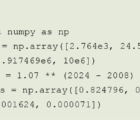 A computer science student runs a simulation that starts on a Thursday and finishes a few weeks later on a Tuesday. The student then starts a more general simulation that same Tuesday. However, with great dismay the student calculates that the new simulation will take a googolplex, 10^(10^100), as many days to finish as the first simulation took. If the student could wait that long, on what day of the week would the new simulation finish?
A computer science student runs a simulation that starts on a Thursday and finishes a few weeks later on a Tuesday. The student then starts a more general simulation that same Tuesday. However, with great dismay the student calculates that the new simulation will take a googolplex, 10^(10^100), as many days to finish as the first simulation took. If the student could wait that long, on what day of the week would the new simulation finish?
Know the answer? Send your solution to ar@casact.org.
Flying Saucers Encircle Earth
This puzzle asked the minimum number of, and lowest altitude for, flying saucers to hover so that at least one saucer is able to hit any point on a perfectly spherical 6,400 kilometer radius Earth at any time with a laser. Three saucers will not be enough. To see this, construct the plane containing these three saucers. Then construct the line perpendicular to this plane and passing through the center of the Earth. At least one of the “poles” where this line intersects the surface of the Earth will be occluded from any laser ray fired from the plane. However, if four saucers hover in a regular tetrahedron formation that contains the Earth, any point on the surface will be a clear shot for a laser from at least one of the saucers. The lowest altitude occurs when the Earth is inscribed in the tetrahedron. The distance from the Earth’s center to the flying saucers is the same as the radius of a sphere circumscribing the tetrahedron. This is three times the radius of the inscribed sphere, namely the Earth, as we discuss below. So, the flying saucers are 3 x 6,400 = 19,200 kilometers from the center of the Earth, or 12,800 kilometers above the surface of the Earth.
By proportionality, it suffices to get the ratio of the radii of the circumscribed to inscribed spheres for any regular tetrahedron. We assume the sides of the tetrahedron have length 1. Describing points as vectors in three-dimensional space, let p1 = (0, 0, 0) and p2 = (1, 0, 0). To construct a third point to form an equilateral triangle let p3 = (1/2) (p1 + p2) + (0, y, 0) = (1/2, y, 0). Since |p1 – p3| = 1, 1/4 + y2 = 1, let y = 31/2/2 so that p3 = (1/2, 31/2/2, 0). To construct a fourth point to form a regular tetrahedron, let p4 = (1/3) (p1 + p2 + p3) + (0, 0, z) = (1/2, 3–1/2/2, z). Since |p1 – p4| = 1, 1/4 + 1/12 + z2 = 1, let z = (2/3)1/2 so that p4 = (1/2, 3–1/2/2, (2/3)1/2). The center of the tetrahedron is c = (1/4)(p1 + p2 + p3 + p4) = (1/2, 3-1/2/2, 6–1/2/2). So the radius of a circumscribed sphere is R = |p1 – c| = (1/2)(3/2)1/2. The center of a face of the tetrahedron is f = (1/3)(p1 + p2 + p3) = (1/2, 3–1/2/2 , 0). So the radius of an inscribed sphere is r = |c – f| = (1/2)(1/6)1/2. R/r =((3/2)/(1/6))1/2 = 91/2 = 3.
Solutions were submitted by Bob Conger, Mario DiCaro, Jim Muza, Brad Rosin, Anthony Salis, Gregory Scruton and David Uhland.
AR Puzzle Editor Jon Evans is president of Convergent Actuarial Services, Inc. in Delray Beach, Florida.













